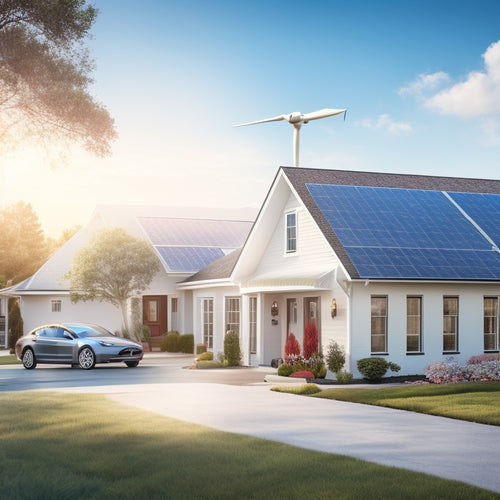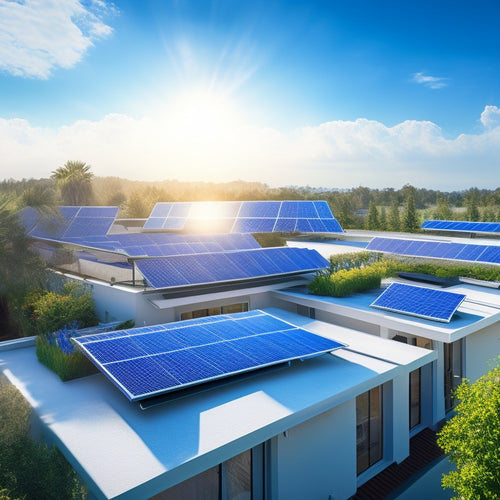
A 10-Step Guide to Installing Solar Systems in Commercial Buildings
Share
To install a solar system in your commercial building, start by evaluating its suitability, examining energy efficiency, and identifying areas for improvement. Next, obtain necessary permits and approvals, researching local building codes and zoning regulations. Then, design the solar system layout, strategically placing panels for maximum energy production, and select high-quality equipment customized to your energy requirements. Budget for equipment and installation expenses, prepare the roof and electrical systems, and install the solar panel array. Finally, connect the system to the grid, test its performance, and monitor its energy production. From here, you'll be well on your way to utilizing the power of solar energy.
Key Takeaways
- Assess the commercial building's suitability for solar installation by evaluating energy efficiency, roof condition, and energy demands.
- Obtain necessary permits and approvals by researching local building codes, submitting detailed plans, and conducting environmental impact assessments.
- Design a solar system layout that strategically places panels for optimal energy production, considering roof space, energy usage, and shading analysis.
- Select high-quality equipment tailored to energy requirements, weighing upfront costs against long-term benefits, and considering financing options.
- Ensure a safe and efficient installation by preparing the roof and electrical infrastructure, verifying electrical safety, and confirming local regulations.
Assessing Commercial Building Suitability
When considering a commercial building for solar system installation, prior to anything else, you must evaluate its suitability. This involves examining the building's energy efficiency and identifying areas for improvement.
You'll need to inspect the roof condition to ascertain it can support the weight of the solar panels and withstand environmental factors. A shading analysis will help determine the impact of surrounding structures or trees on the system's performance.
Next, conduct a load evaluation to determine your building's energy demands and identify opportunities to reduce consumption. Confirm the building's structural integrity can support the added weight of the solar system.
Regulatory compliance is essential, so verify that your installation meets local building codes and standards. Define your energy goals and investigate available financial incentives that can offset the costs.
Develop maintenance plans to guarantee the system operates at peak levels. Finally, consider the environmental impact of your solar system and how it aligns with your organization's sustainability goals.
Obtaining Necessary Permits and Approvals
Securing the necessary permits and approvals is a vital step in the solar system installation process, as it guarantees compliance with local regulations and avoids costly rework or even project cancellation.
You'll need to research and comply with local building codes, zoning regulations, and environmental impact assessments to facilitate a smooth installation process.
Start by identifying the relevant authorities and agencies that oversee solar installations in your area. You'll likely need to submit plans and specifications for your solar system to obtain the necessary permits.
Be prepared to provide detailed information on the system's design, materials, and installation methods.
Additionally, you may need to conduct an environmental impact assessment to ascertain your solar system doesn't harm local ecosystems. This is particularly important if your building is located near sensitive habitats or water sources.
By obtaining the necessary permits and approvals, you can avoid costly delays and guarantee your solar system is installed correctly and safely.
Designing the Solar System Layout
When designing the solar system layout for your commercial building, you'll need to carefully consider solar panel placement to maximize energy production while minimizing structural and aesthetic impacts.
You'll also need to determine the ideal system size, factoring in aspects such as available roof space, energy usage patterns, and local building codes.
Solar Panel Placement
Designing an ideal solar system layout for your commercial building involves strategically placing solar panels to maximize energy harvesting while minimizing potential obstacles.
This requires careful consideration of your building's unique characteristics, including its size, shape, and surroundings.
To achieve the best solar panel placement, you'll need to:
-
Conduct a shading analysis to identify areas where trees, buildings, or other obstructions may cast shadows on your solar panels.
-
Optimize panel orientation to capture the most sunlight throughout the day, considering your building's latitude and the time of year.
-
Select the most suitable panel configuration based on your building's available roof space, structural integrity, and local building codes.
System Sizing Considerations
With your ideal solar panel placement in mind, you're ready to determine the best system size for your commercial building. This involves analyzing your energy consumption patterns through a load analysis, which helps identify your building's peak energy usage.
Consider the roof orientation and potential shading effects from surrounding structures or trees, as these can impact system efficiency. Climate impact is also essential, as local weather conditions can affect energy production.
You'll need to assess your utility rates and financing options to determine the best system size for your budget. Maintenance strategies, such as cleaning schedules and component replacements, should also be factored in.
Don't forget to investigate available tax incentives, which can greatly reduce the upfront cost of your solar system. By carefully considering these factors, you can design a solar system that meets your energy needs while maximizing returns on investment.
A well-sized system will guarantee you're generating enough energy to power your building while minimizing waste and excess capacity.
Selecting and Purchasing Equipment
You'll need to select high-quality system components that meet your commercial building's specific energy requirements and guarantee a reliable, efficient solar system operation.
As you budget for equipment, you'll want to weigh the upfront costs against the long-term benefits of each component, considering factors like durability, performance, and warranty.
System Component Selection
How do you guarantee that your commercial solar system operates at peak efficiency and meets your energy goals? The answer lies in careful system component selection.
You need to choose the right equipment to confirm your system performs at its best and provides the desired ROI.
When selecting components, consider the following key factors:
-
Inverter types: String inverters, microinverters, and power optimizers each have their advantages and disadvantages. Choose the one that best suits your system's design and energy requirements.
-
Battery storage: If you're incorporating energy storage into your system, select batteries that offer the necessary capacity, depth of discharge, and cycle life to meet your energy goals.
-
Module selection: Choose high-efficiency solar modules with a proven track record of reliability and performance. Consider factors like temperature coefficient, warranty, and durability.
Budgeting for Equipment
As you've carefully selected the components for your commercial solar system, it's now time to allocate the necessary budget for equipment. This step is essential, as it directly impacts the feasibility and profitability of your project.
You'll need to conduct a thorough cost analysis to determine the total expenditure required for the equipment, installation, and maintenance of your solar system.
When budgeting for equipment, consider the upfront costs, including the solar panels, inverters, mounting structures, and other necessary components. You should also factor in the costs associated with installation, such as labor, permits, and inspections.
Additionally, consider the ongoing expenses, including maintenance, repairs, and replacement of components.
To make your project more financially viable, investigate available financing options, such as loans, grants, and tax incentives. Many commercial solar system installations can be financed through power purchase agreements (PPAs) or solar leases, which can reduce upfront costs and provide predictable energy expenses.
Preparing the Roof and Electrical
Before installing a solar system, the roof and electrical infrastructure of a commercial building must be assessed and prepared to confirm a safe and efficient integration.
You'll need to evaluate the roof's integrity to verify it can support the weight of the solar panels and withstand environmental factors like wind and rain. Additionally, you'll need to verify that the electrical system can handle the increased power output from the solar panels.
To prepare the roof and electrical infrastructure, you should:
-
Inspect the roof for damaged, rotten, or missing tiles, and repair or replace them as needed to guarantee a watertight seal.
-
Verify electrical safety by checking the electrical panel's capacity, confirming it can handle the increased power output from the solar panels, and making any necessary upgrades.
-
Identify potential shading issues, such as nearby trees or buildings, to verify peak solar panel performance.
Installing the Solar Panel Array
With the roof and electrical infrastructure prepared, you're ready to install the solar panel array. This involves selecting the right solar panel materials and employing proper installation techniques to guarantee peak energy production and longevity.
Solar Panel Installation Considerations
| Factor | Description | Importance |
|---|---|---|
| Panel Angle | Adjusting panel angle to match roof pitch and latitude | High |
| Panel Spacing | Maintaining adequate spacing for airflow and cleaning | Medium |
| Mounting System | Selecting a sturdy and corrosion-resistant mounting system | High |
| Wiring and Connectors | Using weather-resistant wiring and connectors to prevent damage | High |
When installing the solar panel array, verify that the panels are securely fastened to the roof and electrical connections are made according to the manufacturer's instructions. Proper installation will not only guarantee energy production but also ensure the safety of the building's occupants and the system itself.
Connecting to the Grid and Testing
Your solar panel array is now installed, and it's time to connect it to the grid and guarantee it's functioning as expected. This essential step guarantees that your system is safely and efficiently feeding electricity back into the grid.
To guarantee a seamless grid integration, you'll need to:
- Install a grid-tie inverter that synchronizes your solar power output with the grid's frequency and voltage.
- Connect your system to the electrical panel and verify all necessary electrical connections are secure.
- Configure your performance monitoring system to track your energy production, consumption, and grid feed-in.
Proper connection and testing are fundamental to guaranteeing your system operates at peak levels.
Your performance monitoring system will provide useful perspectives into your energy usage and help you identify areas for improvement.
Frequently Asked Questions
Can Solar Panels Be Installed on a Building With Multiple Owners?
You can install solar panels on a building with multiple owners, but you'll need to establish co-ownership agreements that outline energy cost sharing and maintenance responsibilities, ensuring a seamless and mutually beneficial experience for all parties involved.
How Do I Handle Potential Roof Leaks After Installation?
You'll rest easier knowing that a thorough roof inspection before installation can pinpoint potential leak-prone areas, allowing you to take preventative measures, and incorporating leak prevention strategies, like waterproofing, into your solar system design.
Are There Any Government Incentives for Commercial Solar Installations?
You'll be pleased to know that yes, there are government incentives for commercial solar installations, including tax credits and financing options, which can greatly reduce your upfront costs and increase your ROI, making the investment even more attractive.
Can I Install a Solar System on a Leased Commercial Property?
You'll need to review your lease agreements to determine tenant responsibilities and potential restrictions on installing a solar system on a leased commercial property, ensuring you're not violating any terms and can negotiate necessary modifications.
Do Solar Panels Require Regular Cleaning and Maintenance?
You'll want to clean your solar panels regularly to maximize energy output. Typical maintenance frequency is every 6-12 months, depending on your location and environmental factors, ensuring ideal performance and extending the system's lifespan.
Conclusion
You've successfully maneuvered through the 10-step expedition to installing a solar system in your commercial building. Now, your property is utilizing the power of the sun, reducing energy costs, and contributing to a sustainable future. Like a ship charting a new course, your business is blazing a trail towards a cleaner, greener horizon. According to the US Department of Energy, commercial buildings that invest in solar energy can save up to $1,000 per year on electricity bills. Congratulations, you're now part of the renewable energy revolution!
Related Posts
-

Why Go Green With Automotive Products Online?
By switching to eco-friendly automotive products online, you're taking a significant step towards reducing your carbo...
-

Why Homeowners Are Embracing DIY Energy Independence
By taking control of your energy needs, you're breaking free from the uncertainty of utility bills and embracing a se...
-

Best Solar Panel Options for Maximum Energy Savings
You can maximize your energy savings with solar panels that boast efficiency ratings above 20%, paired with extensive...


